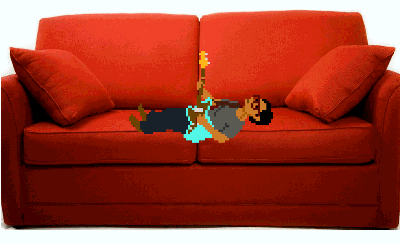
Mark Denardo gif by Alex Bond, aka Enso; shrunk and couched by D_MAGIK; optimized
Update: The above is a heavily optimized/reduced version of a 5.4 MB GIF made using the Photoblaster website.

Mark Denardo gif by Alex Bond, aka Enso; shrunk and couched by D_MAGIK; optimized
Update: The above is a heavily optimized/reduced version of a 5.4 MB GIF made using the Photoblaster website.
The Michael Manning-organized exhibition-on-a-stick (as in USB) that includes (included?) some work of mine was written about on:
ARTINFO's Kyle Chayka writes:
The exhibition is a species of "Dead Drop," a genre of digital art exhibition (or publication, or seeding) originally conceived by Aram Bartholl that involves loading up a USB with art and leaving it up to the viewer to decide what to do with it: exhibition-goers are free to download the contents of the USB, delete or alter them, or upload their own work. Once it has "dropped" in public, all bets are off. The strategy brings a needed physical dimension and an imposed scarcity to work that is difficult to pin down to a particular source or venue. In the case of "Street Show: The Things Between Us," Eyebeam is not so much the exhibition's venue as merely the location of the "drop."
and
The über-public, democratic nature of Manning's "Street Show" puts it in the standard open discourse of Internet art, but its artificial scarcity provides an interesting element of danger and chance of loss to the viewing experience, feelings not normally applicable to safely viewing from an Internet browser.
Let's forget for the moment that all the content was immediately scooped up and "put back on the net" and consider the idea of artificial scarcity. Usually in new-media-friendly discussions "scarcity" is a word aimed at those backward art galleries* that try to create markets by selling unique objects. Here the scarcity was self-imposed, ironically (although not stated in the exhibition prospectus, I think we can assume this), in reaction to Rhizome.org's recent effort to sell GIFs at the Armory art fair with some possibly poorly considered words ("we're taking it offline so the collector can have it locally"). Let's give Rhizome's director Lauren Cornell the benefit of a doubt and note that these words (which would seem to contradict the open source goals of many artists working with software) weren't officially published but were uttered when a roving reporter aimed a video camera at her at the Armory table. The maker of the GIF in question has since clarified that she takes work on and offline as part of her practice but no explanation has been given about the implication that it was done for the collector's benefit or convenience (which would be kind of gnarly).
*Three years ago, in a panel on the "Future of the Internet," Cornell [14:05 on the video] talked about the art world as a system "based on an economics of scarcity" and suggested alternate ways that artists could make money (e.g., moving more to the musical band model--she didn't elaborate). "Taking the work offline so the collector can have it locally" was not on the agenda at that time.